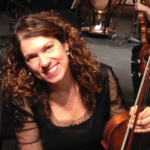 by Rochelle Skolnick, AFM Symphonic Services Division Director
by Rochelle Skolnick, AFM Symphonic Services Division Director
Welcome to the 2018 Symphonic Services Division (SSD) special edition of the International Musician! In this issue we focus attention on a range of musician-led initiatives to connect musicians with their communities in ways that yield benefits for all involved. We also return to our roots with articles from SSD staff focusing on some fundamental responsibilities of orchestra committees: organizing, in preparation for bargaining, between rounds of bargaining, and administering the Integrated Media Agreement. And, we profile Baltimore Symphony oboist Michael Lisicky of Local 40-543, whose history of orchestral activism provides a compelling model for younger musicians. This issue contains ample doses of both inspiration and information and I couldn’t be prouder of the finished product.
I recently heard someone describe what we do as artists and musicians as imparting some of our soul directly to our audiences and listeners. Writers throughout time have observed the connections between music and spirit and marveled at music’s power to open humankind to our deepest, most ineffable feelings. Musicians work hard to engage with audiences at this level. They spend countless hours refining their craft and filling their toolboxes so that, at the moment of performance, they are able to draw seamlessly on their skills to create magical experiences.
Undertaken in a concert hall, with the audience sitting hushed in darkness and focused intently on the stage, the work of symphony orchestra musicians reaches ever greater heights of artistic excellence. I’m reminded of this every time I hear one of our symphony orchestras in its home venue or visiting on the stage of Carnegie Hall. These moments yield the kind of peak performance experiences that drew most of us into the field as children and teenagers. These performances are the raison d’être of the professional symphony orchestra and always will be.
But these are not the only circumstances in which musicians work their particular brand of magic. Peak experiences of a different kind occur when musicians engage with members of their community who may not otherwise find their way to the concert hall and when musicians meet members of their community on their own terms and in their own spaces. These exchanges cannot replace what happens in the quasi-sacred space of the concert hall. But exchanges in which musicians place themselves and their art in the direct, immediate service of their communities have the capacity to enrich the lives of everyone involved.
Musician-led community outreach also plays a critical role in helping our communities understand who we, the musicians, are. Time after time, musicians have seen the significance of community support, not only for their orchestra institutions, but for the musicians themselves. At no time does that support and engagement become more vital than when contract negotiations become contentious and musicians find themselves in conflict with their institutional leadership. In moments like these, being able to draw on the goodwill of a broad community of patrons and donors, who know us as neighbors and citizens of the community in our own right, can make the difference between a successful contract negotiation and a protracted and toxic work stoppage. And when efforts to reach out to our communities are genuine and authentic, audience members enthusiastically return to us some of the spirit we’ve imparted to them by lending their support to our cause.
In talking with musicians as we researched and prepared the content for this special issue, I was struck by the creativity and compassion musicians demonstrate in their efforts to bring their art to those in their communities who may need it most. As you read about their efforts, I encourage you to think, if you haven’t done so already, about the ways the musicians of your own orchestra could begin to build outreach efforts and create a space for yourselves within your communities that goes beyond the confines of the concert hall and doesn’t rely on your management to implement. Consider projects that spark passion among your musician colleagues and assess the unique needs of your community. At the intersection of these two forces you’ll likely find a niche for your work. As this month’s coverage demonstrates, creating connection with our communities can take many different forms. I can’t wait to hear what you’re inspired to do!


